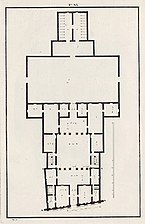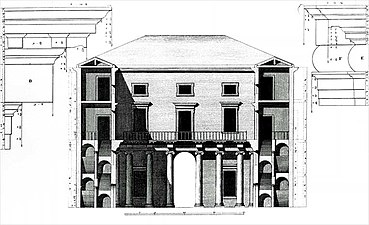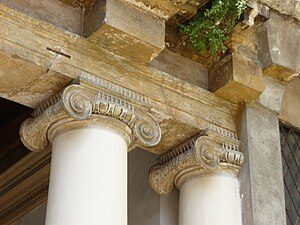Palazzo Valmarana
| UNESCO World Heritage Site | |
|---|---|
 | |
| Location | Vicenza, Province of Vicenza, Veneto, Italy |
| Part of | City of Vicenza and the Palladian Villas of the Veneto |
| Criteria | Cultural: (i)(ii) |
| Reference | 712bis-001 |
| Inscription | 1994 (18th Session) |
| Coordinates | 45°32′52″N 11°32′37″E / 45.54778°N 11.54361°E |
Palazzo Valmarana is a palace in Vicenza. It was built by Italian Renaissance architect Andrea Palladio in 1565 for the noblewoman Isabella Nogarola Valmarana. Since 1994 it is part of the UNESCO World Heritage Site "City of Vicenza and the Palladian Villas of the Veneto".[1]
History

The foundation medal of this building bears engraved the date 1566 as well as the bust of Isabella Nogarola
On the site later occupied by the new 16th century (Cinquecento) palace, the Valmarana family possessed buildings right from the end of the 15th century (Quattrocento), which were progressively combined until they became the object of Palladio’s renovation. The planimetric irregularity of the internal spaces doubtless derives from the oblique orientation of the façade and of pre-existing walls. In this sense it becomes quite evident just how much the Olympian regularity of the palace illustrated in I quattro libri dell'architettura (1570) was the product of Palladio’s usual theoretical abstraction, especially since not only was the extension of the palace beyond the square courtyard never realised, but nor does it seem it was even intended by Leonardo Valmarana, who bought up neighbouring properties rather than continuing the construction of the family palace.
The palazzo was heavily damaged during the World War II by an Allied bombing on 18 March 1945. The roof, part of the attic and most of the main hall at the piano nobile were destroyed. The façade however remained intact, and today represents a rare example of a façade surviving with its original plaster and marmorino. In 1960, the ruined palace was sold by the Valmarana family to Vittor Luigi Braga Rosa, who led an extended restoration, rebuilding the parts demolished by war. He also enriched the palace with many decorations and artworks, coming from other destroyed palaces, in particular a collection of Seicento paintings by Giulio Carpioni with mythological themes.
Description
The
Rather than abstract geometrical constructions, the compositional logic of these civil and religious façades derived from Palladio’s familiarity with the techniques of draughting, in particular the
-
Floor plan (Ottavio Bertotti Scamozzi, 1776)
-
Cross section (Ottavio Bertotti Scamozzi, 1776)
-
The loggia at the entrance, seen from the inner courtyard
-
Detail of Ionic capitals in the loggia
-
Detail of the only floor section of piano nobile hall survived to Allied bombing in 1945
See also
References
- ^ Forum Center - Comune Di Vicenza - Vicenza Città Unesco Archived 24 June 2016 at the Wayback Machine
- ISBN 978-0-262-70031-3.








